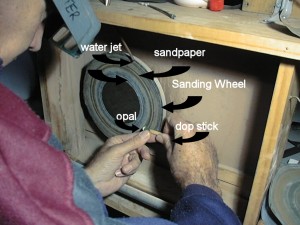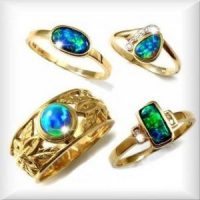
Lapidary Advice for cutters and repairers
The term ‘lapidary’ refers to the art of cutting and polishing stone. Lapidary advice for cutters and repairers can be obtained on sites like this and also at Lapidary clubs where machines are often available to practice on.
Check online in your area to find the closest club, or leave your comments in this blog if you need some help locating one.
How opal is graded and sold
The correct lapidary advice will teach you to grade Rough opal parcels and sort them into three grades: tops, middle, and low. Each tops parcel has a King stone, which is the best stone in the parcel.
Some parcels have several King stones. Color is the primary criteria for grading, but the graders also take into consideration the number of imperfections and faults, and whether a stone is the right shape to be cut into an oval or one of the other popular shapes.
You can buy rough opal in several different conditions.
Mine Run. Direct from the mine. The stones have not been cut or ground down. This means that there is more guess work in the cutting. Purchasing mine run opal can be risky if you are not very experienced.
Off Cuts. The miner has removed whatever opal he has a market for and sells you what’s left. With off cuts, you can usually tell what you are going to be able to cut. You must still watch for cracks in the opal because once a crack becomes obvious, a stone can lose half its value.
Rubs. This can often be the best way of buying rough if you are not very experienced. The miner has cut and ground the stones into basic shapes, after having removed most of the rubbish. What you have left is the stone nearly ready for the dopping and polishing process. You have the satisfaction of cutting your own stones without the high risk of buying mine run rough.
Opal is officially sold in troy oz. There are 20 D.W.T. pennyweights to a troy oz. There are approximately 30 grams to a troy oz and approximately 30 oz to a kilo.
Lapidary Advice for cutters and repairers
Here’s an eclectic assortment of hints and tips you may find helpful when buying or working with opals.
1. Not all opals are valuable. Potch, sometimes called “common opal” does not reflect colors. Potch does have its use, however, as a backing for doublets and triplets. When there is color mixed with potch it’s called “potch and color.”
2. Some classes of rough opals are unsuitable for making gemstones. Some are very porous. Others have a chalky appearance. Still others can lose their color in a short period of time. And yes, it is common for certain types of opals to shatter in a dry atmosphere when the water from the gel evaporates.
The best protection for buyers is to purchase opal from a knowledgeable and reputable dealer who accurately details exactly what you are purchasing and is willing to guarantee the stones. Note: If you buy rough opals, there is no guarantee that it will not crack. This is the calculated risk you take and is part of the “excitement” of opal cutting and gaining Lapidary Advice for cutters and repairers
3. When examining opal jewelry, look at the stone from the side to determine whether it’s a triplet. Solid and doublet opal domes are simply the opal formed into a curved dome shape. Triplets have clear crystal domes to protect the flat opal surface.
4. It is very difficult to tell whether a stone is a doublet or a solid if it is in a setting. It helps if the back of the setting is open, but it is still no real indication because the back of a doublet and a solid looks very similar, although a doublet is usually perfectly black on the back whereas a solid black opal usually has some imperfections.
So if the back of a stone looks too perfect, you have to be a little suspicious. For this reason, it’s best to buy opal from reputable dealers who know what they are doing and can give you lapidary advice because, unfortunately, many jewelers also are not experienced in opals.
5. When buying opal over the net, ask the seller to give you a summary of how close the graphic sample is to the real thing. Opal is very difficult to photograph and the appearance on the computer screen may give it a different look.
Particularly is this the case in regards to size. Graphics come out in all different sizes, usually a lot larger than actual…so make sure you get your ruler out and actually draw the size on a piece of paper so that you will know in your own mind’s eye the actual size of the stone. Here are some examples of rough opal available on this site
6. The same thing applies to the color of the stone. Make sure you get the supplier to give a commentary on the color so that you will know pretty well what you are getting. The camera sometimes picks up colors that are only minimal, while ignoring the feature colors. We hope that this Lapidary Advice for cutters and repairers will help you enter into a new world of excitement.
Cutting Tips and more Lapidary Advice

Lapidary Opal Sanding and Polishing machine
To get all the advice in one book, please consider buying ‘Ordinary Bloke’s Guide to Opal’ in either CD form or e-book form. Click here for details. And if you would like some details of the opal fields check here
Opal is one of the easiest stones to cut. The trick is chasing the color to make sure you approach the precious opal from the right direction.
Lapidary clubs are a good resource for new opal cutters. Ask experienced members for advice on the basics of cabochon cutting. Mind you, many of them are not familiar with opal so it will be an advantage to have a reference book to turn to
Your first task is to search an opal for any hint of color. Then, you use a wet grindstone to grind off the potch until you can see where the color is going. When you’ve exposed enough color, you can choose the top and bottom for your stone based on where you see the best color contrasted against the background color.
Let the stone dry then check for cracks and imperfections. Everyone wants to cut a big stone, but two or three smaller perfect stones are a better choice than one big stone with imperfections.This is good lapidary advice.
Remember too, if you’re planning to make a jewelry piece, settings come in standard, calibrated sizes. Unless you’ll be making a completely custom setting, you’re better off sticking with a common size.
A diamond blade, 10 thousandths thick is a good choice for cutting an opal stone to size. Many lapidaries will tell you to run the diamond blade slowly with opal. This is a big mistake. Opal is not a hard material like agate, for example.
Opal slicing is best done either in water or with water passing over it at the speed achieved from an ordinary 1440 RPM, 1/4 H.P. motor with a 6″ pulley on the motor and a 1 & 1/2 pulley on the shaft. If you don’t force the stone and you have plenty of water passing over it, you will not cause any damage.
In fact your diamond blades will last longer because they will not buckle as easy. After you’ve cut the stone into the basic shape, use a wet grinder to finish shaping and remove rough edges.
The final bit of lapidary advice we can give you is in the matter of sanding. Begin sanding with a 320 grit paper. If the paper is new, you may rub it on some potch* or a sheet of glass to dull its sharpness a bit.
You can then use either a 600,700, or 800 grit wet and dry sandpaper to gradually take out the finer scratches and bring up a mat polish. Finally, on a leather lap, use a paste of cerium or tin oxide (mix with water) to bring up the final polish. Your finished opal should have a nice, high dome for easy mounting.
Save the chips! You can use those bits of opal to create stunning mosaic patterns.
If you have a piece of opal jewelry that has become scratched or dull, just use the finer papers (700 or 800 grit) you can try to work the above process by hand by cutting small strips of the sandpaper and just rubbing them back and forth across the stone until the scratches are taken out.
If the paper is too harsh, just tone it down by rubbing it on a piece of glass. Next step is to get a piece of old sheet or pillow slip (cloth) and vigorously polish with tin oxide or cerium oxide.
If you want to polish the gold or silver at the same time, use some metal polishing paste. Most of these items can be purchased from the hardware store, with the exception of the oxides which may only be available at Lapidary supply stores or at workshops that polish gravestones. For Stone masons, check in your yellow or pink pages on the telephone directory for locations.
*potch is unformed opal
Lapidary advice for cutting, polishing, and repairing opals is extensive on this site. if you want to get a really in-depth knowledge of the subject. Click here







A pleasure Alexandre peter
Chris, i think i spoke to you about this recently. Sorry, i forget. if not, please let me know but in the meantime you are welcome to have a free copy of my eBook which will tell you everything about the opal industry. enjoy: http://issuu.com/brusaschi/docs/opal_bloke_book-free_version-revised
If I buy diamond discs with the grits embedded to cut the opal, the same as the wheels have, would this work as well as the wheels.
I am finding people prefer the wheels as they say it is easier to cut cabochons on the wheel but if I learnt with potch on the diamond disks (vertical not lap) will they cut nice stones?
I believe the old blokes used to use only discs in the old days so am curious to know if discs are still ok to use.
Is it merely personal preference or is there a definite advantage in using wheels instead of vertical disks?